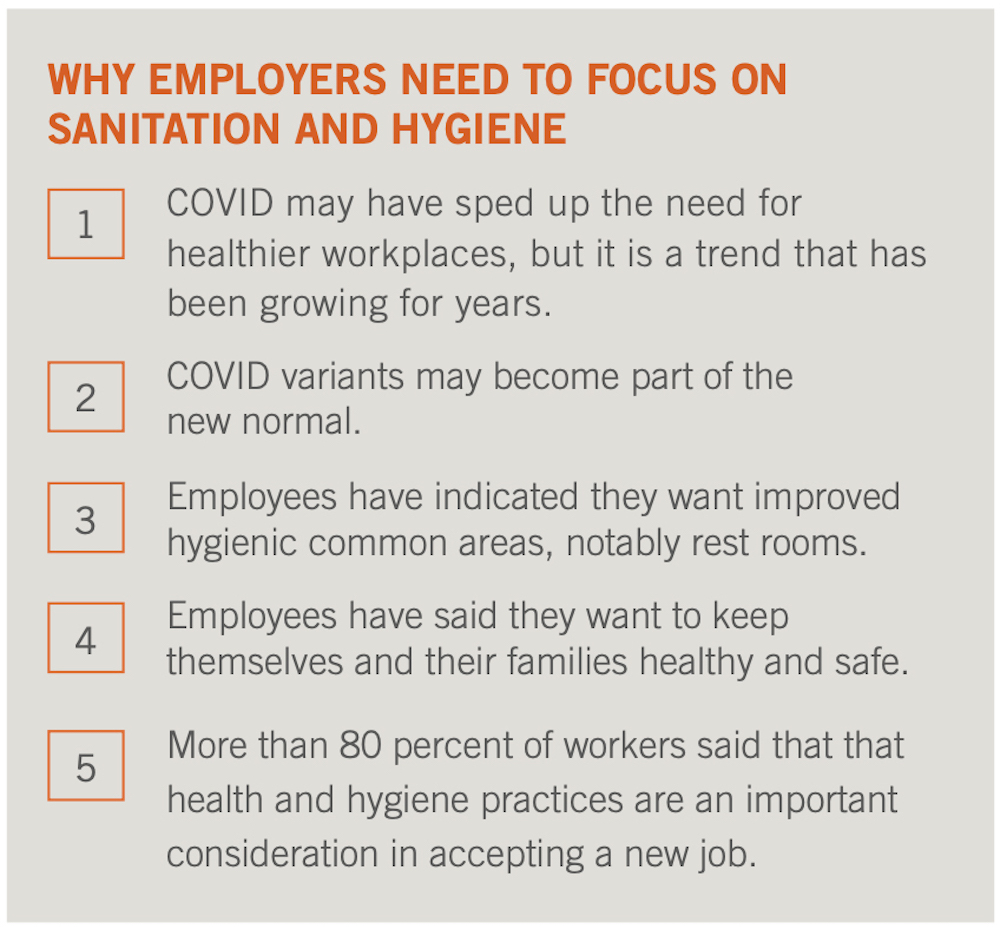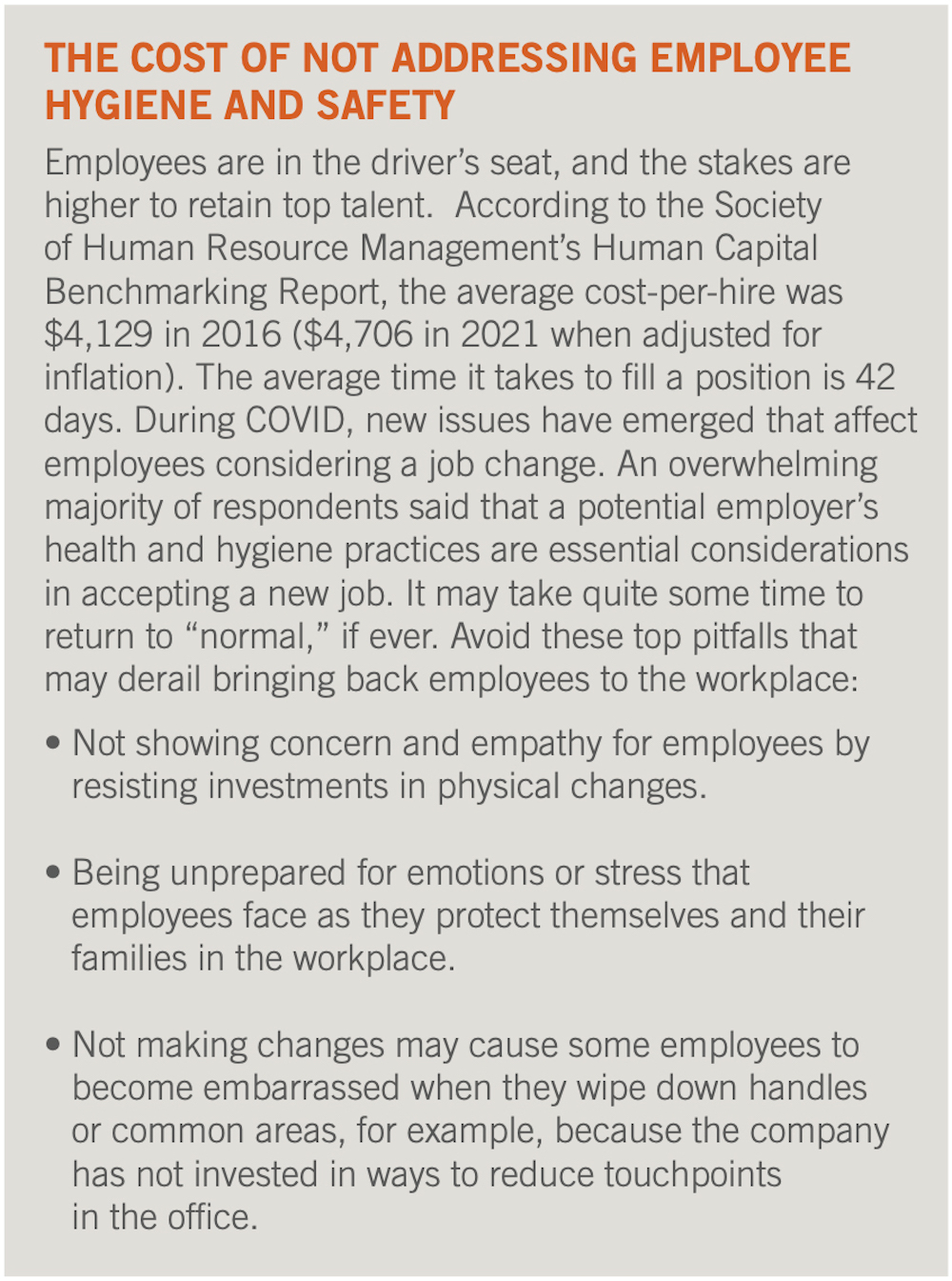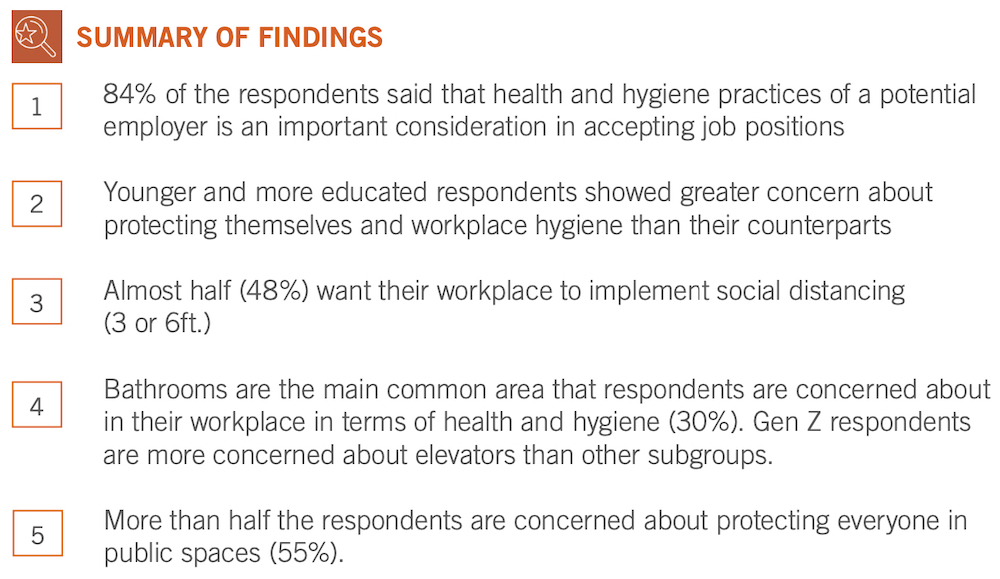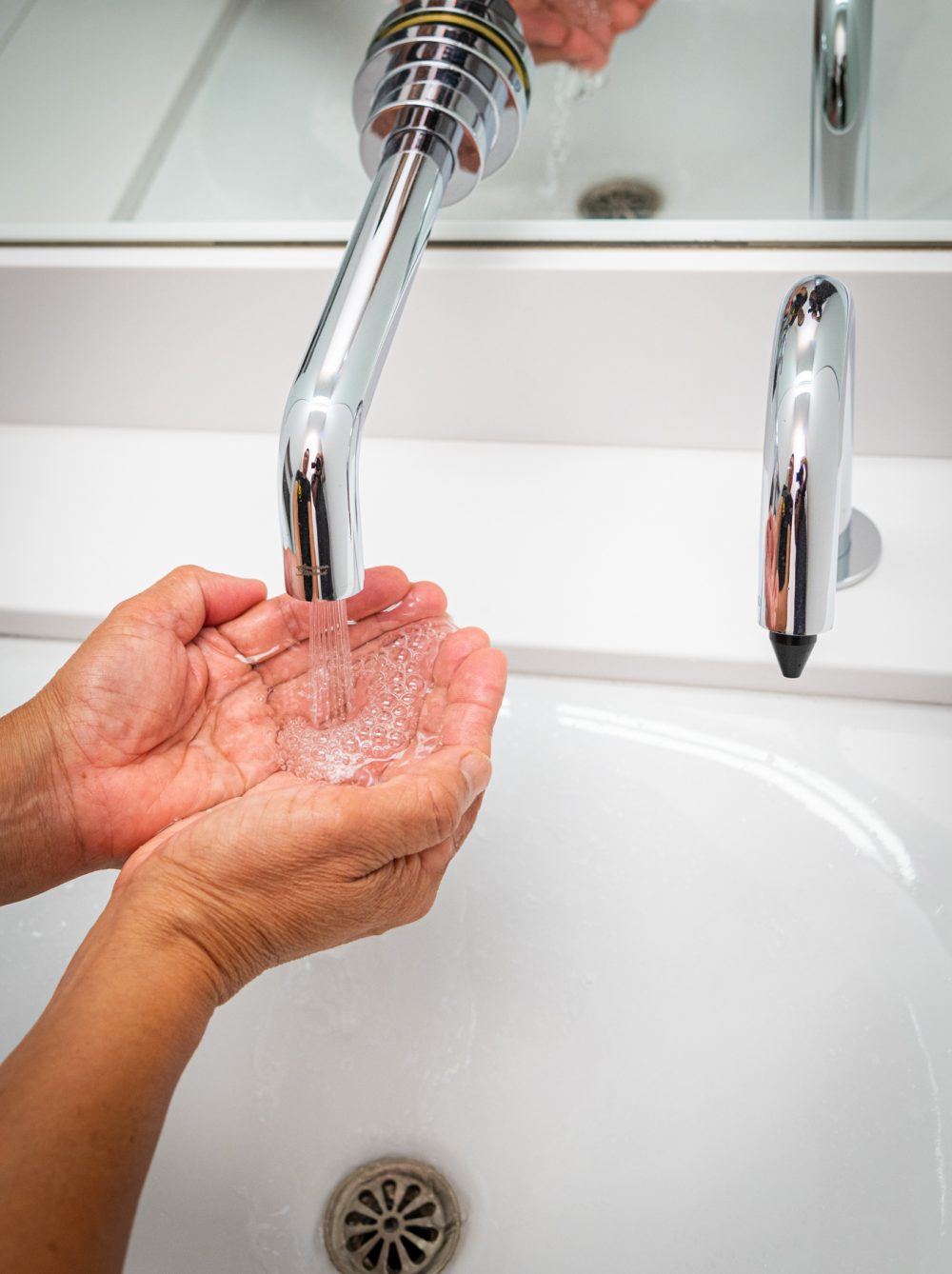As employees return to the office – here’s what they are expecting.
Going to the office used to be an understood norm. Companies quickly reacted to the COVID pandemic by pivoting from office to remote work. As employers consider their return-to-the-office options, employees say they want a workplace with improved hygiene that protects their health.
At the same time, employees are quitting or changing jobs at record levels. An overwhelming majority of recent survey respondents (84%) said that health and hygiene practices are an important consideration in accepting a new job. Architects and designers have a larger role than they know in helping their clients attract and retain employees by reimagining workplaces with a greater focus on health and wellness.
ENSURING EMPLOYEE HEALTH AND HYGIENE IN THE WORKPLACE
Much has been written about the “Great Resignation.” Rather than leaving the workforce entirely, many are simply going somewhere else. That’s why some prefer to call it “the “Great Migration.” Microsoft CEO Satya Nadella calls it “the Great Reshuffle.”
So why do employees leave? Research cited in a recent Inc. Magazine article says the explanation boils down to four words: feedback that goes unheard. Employees want their voices to be heard, and they want to work for organizations that share their values.
THE NEED FOR HEALTHIER WORKPLACES
So, what do employees want? Just recently, a Harris Poll survey of employed people in the U.S. asked which top issues should be the focus for their employer. The number one issue? Employee health and wellness.
As more people became fully vaccinated in 2021, there was renewed interest in bringing back employees to the office – either full-time or in a hybrid workplace environment. Then the Delta variant hit, then Omicron, and now BA2.
COVID-19 variants may become part of the new normal, as reported by USA Today recently. In the article, Lauren Ancel Meyers, a professor of statistical and data science and director of the COVID-19 Modeling Consortium at the University of Texas at Austin, states, “We haven’t had anything that looks like normal yet.” But to encourage employees back to in-person workplaces, better office hygiene is a key part of assuring them that their employer is investing in ways to keep them safe and healthy.
LIXIL conducted its own research recently with the Harris Poll, in which 84% of respondents said that health and hygiene practices are an important consideration in accepting a new job.
But to encourage employees back to in-person workplaces, better office hygiene is a key part of assuring them that their employer is investing in ways to keep them safe and healthy.
Further, LIXIL’s research with Harris shows that respondents not only want to protect themselves but are mindful of being safe at the workplace to avoid bringing home the virus to their friends and family. As a result, employees expect that their organizations will implement new procedures and physical changes to the work environment to promote hygiene and safety.
As many as 80% of workers indicated they want their workplace to implement tangible changes. Half of respondents want social distancing between desks 3-6 feet (the top answer), followed by masking (44%), improvements to air purification and ventilation systems (40%), and touchless fixtures in bathrooms, kitchens and other common areas (36%).
Office environments typically have common areas including bathrooms, kitchens and break rooms, large conference rooms and elevators. A plurality of survey respondents (30%) indicated that bathrooms are the common area in their workplace they are most concerned about – and among those respondents, nearly half want touchless fixtures and expect their company to add hand sanitizing stations.
“Until 18 months ago, almost nobody cared about ‘healthy buildings,’” said Angelo Bianco, managing partner of CP Group, a building owner and management company, in an article in The New York Times. “That’s irrevocably changed.”

In a recent report from JLL, a commercial real estate services company, 75% of employees claimed they expect to feel protected at work, clearly indicating that both mental and physical health will remain a key priority for employers to support their people.
OPPORTUNITY FOR EMPLOYERS
While adhering to OSHA requirements for proper safety may be mandatory, employees state they want their employer to go beyond what is required to show commitment to their health and wellbeing. Physical changes also become a way employers can differentiate themselves in the marketplace by raising their employees’ comfort level about returning to the office.
Be proactive and demonstrate care through actions and facilities upgrades. Use the time prior to inviting employees back to the office as an opportunity to reimagine the workplace and create safer spaces and healthier buildings beyond simply mandating vaccines or testing. Redesign and retrofit common areas, such as bathrooms, meeting rooms, kitchen spaces and entryways, to reduce physical touchpoints using innovations that already exist in the marketplace.
HERE ARE SOME EXAMPLES
Improve employer branding by explicitly linking workplace changes to the company’s mission and values. Demonstrate a commitment to creating a workplace that supports employees in all situations by investing in the changes that matter to them.
Regularly poll employees to understand any other concerns about returning to the office to ensure they are heard.
Follow established OSHA and CDC guidelines and correct misinformation around COVID, vaccines and protective measures.
Handwashing remains one of the best ways to protect against illness. Making that process easier and healthier is one of the top ways to lower barriers to people using common area faucets.
According to a paper from Hanley Wood University, “[Touchless] faucets are doubly significant because they greatly decrease instances of cross contamination resulting from multiple people handling infecting faucets. In fact, healthcare and school food service, or any foodservice employee for that matter, may even wash more frequently because of hands-free faucet activation.”
WHAT INDUSTRY LEADERS ARE HEARING
Architects, designers and facility managers have shown great interest in utilizing the office space that has largely been unused during the past two years. They are looking for ways to assure occupants that their facilities are safe.

And yet it’s clear that many in the industry, even while meaning well, are not aware of what’s on the mind of employees who must consider how to keep themselves safe. Requiring vaccinations, testing and masks are steps in the right direction, but fall short of elevating the long-term comfort of those who use common areas.
HOW EMPLOYERS CAN ACT
First, ask employees what’s on their minds regarding returning to the office. Take surveys or set up focus groups to research the topics that LIXIL’s research has identified to determine priority concerns.
Second, partner with architecture and design firms and property management companies to discuss the innovations already in the marketplace that can help lower the number of touch points employees experience in their workplace. For example, there are several options available to retrofit bathrooms with touchless faucets, soap dispensers, restroom stall doors, toilet flushers and paper towel dispensers, among others.
“When we return to our physical workplaces, we need to rethink how we introduce interfaces that aren’t just frictionless, but also touchless,” said Lee Billington, former director of connected experiences at Gensler, a global architecture, design, and planning firm. ‘We should start by looking strategically at the various technologies already available to us.”
CONCLUSION
Evaluating what’s on the minds of end-user employees and developing an action plan to upgrade building infrastructure to lower the number of touchpoints are core components of ensuring the comfort of employees asked to return to the workplace. Architects and designers are uniquely qualified to proactively approach their commercial clients to discuss innovative ways to use existing technologies to reduce touchpoints in the work environment.
As the war for talent continues to escalate, employers and facility managers will want to use every option available to keep their employees from leaving and instead return to the office. Employees are focusing on health and hygiene, not just simply pay and benefits.
Returning to the office may look different – and that’s what employees are counting on.
REFERENCES:
- Integral Employee Activation Index with the Harris Poll, Summer 2021, of 2,000 people employed in the US.
- LIXIL survey with Harris Poll, December 2021, of 1,200 people employed in the US.
APPENDIX: POLL RESULTS
Methodology
From Nov 30 – Dec 2, 2021, the Harris Poll conducted a survey of 1,141 US adults who were employed either full- or part-time, or were self-employed. The survey was commissioned by LIXIL in order to better understand employees’ attitudes around health and hygiene in the workplace. Statistical testing was done at the 95% level of significance.
The following generation definition were used:
- Gen Z: 18-24 years
- Millennials: 25-40 years
- Gen X: 41-56 years
- Boomers: 57-75




